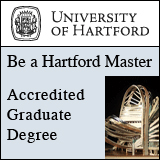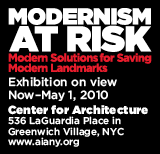
Today’s News - Wednesday, March 31, 2010
• Ouroussoff cheers Haiti's new direction in urban planning: it "could become a reliable blueprint not just for reconstruction, but also for solving many of the urban ills that have plagued the country for decades."
• McGuirk on our new urban age and "how cities became our greatest design challenge yet."
• A tool that can help is GIS technology: the challenge is getting architects on board - "We don't have time to make geodesign a back-burner issue."
• Ray C. Anderson (one of our faves) offers an eloquent essay about what he sees "as a shifting mind-set, a growing sense of ethics" that could (and should) lead us to "less stuff, more happiness."
• Abu Dhabi raises its profile with a new, towering skyline, "taller and slicker than the glass edifices of yesteryear."
• It should start thinking more about its green spaces, especially for its urban residents who are being "encouraged to walk more and to use cars less."
• Calys on the transformation of San Francisco's urban alleys into "quaint" and/or "hip" places.
• Poletti ponders the rebirth of a Pflueger movie palace in Alameda, CA, that "shows the halo effect that can happen after a historic theater is put into use again" in a city bruised by the recession.
• Huxtable hails Snøhetta for more than just its architecture, particularly its perseverance at Ground Zero.
• Kieran Long on London's most eco-friendly building: it's about as green as it could get, but even with all its technology, it "can't conceal the feeling that something is awry" with making it an "exemplar of sustainable architecture."
• Shuttleworth has his say about carbon efficiency and honest design: buildings still have to be beautiful, but "there is a cultural change away from big, blingy glass and gold boxes...to a more sensible approach."
• In Melbourne, a utilitarian structure for train yardmasters and signalmen is "more like a jewelry box wedged between the tracks."
• King on IwamotoScott's moving beyond "the clublike world of architectural theory" to actual buildings (sort of).
• Rochon rues the "glut of design disasters happening in our neighborhoods" while all the "architectural pizzazz" is happening in Toronto.
• Lewis laments the lack of a market for modern homes: "change in the near future is unlikely."
• Kennicott gives (mostly) thumbs-up to "I.M. Pei: Building China Modern" (on PBS tonight): it doesn't deal with all the issues it raises, "but never mind...the visuals are lovely...Pei is also lovely...and given to pronouncements that are both revelatory and poetic."
• Van Valkenburgh takes the 2010 Arnold W. Brunner Memorial Prize in Architecture: "the only living GSD professor" to get the award (and rarely given to a landscape architect, to boot).
• One we couldn't resist: a university plans to save a lot of green bucks by switching fonts (who knew printer ink costs around $10,000 a gallon!).
| |



|
|
|
To subscribe to the free daily newsletter
click here
|
A Plan to Spur Growth Away From Haiti’s Capital: ...would redistribute large parts of Port-au-Prince’s population to cities less vulnerable to natural disasters...could become a reliable blueprint not just for reconstruction, but also for solving many of the urban ills that have plagued the country for decades. By Nicolai Ouroussoff -- Leslie Voltaire; Wendy Caraballo; Gustavo Sanchez; Mark Schreiber; Habitat for Humanity [images]- New York Times |
The urban age: how cities became our greatest design challenge yet: The question is this: how do we create cities that are not just containers for tightly-packed populations, but pleasant and equitable places to live? By Justin McGuirk- Guardian (UK) |
Meet the Geodesigner: GIS technology, long relied on by planners, is making inroads into architecture. What happens when data-rich map layers meet 3D building designs? ...the challenge is getting architects to think about data as part of a creative decision-making process and to translate geospatial analysis into built form...“We don’t have time to make geodesign a back-burner issue.” -- ESRI/Environmental Systems Research Institute; Thomas Fisher; Nicholas de Monchaux; Foster + Partners- Architect Magazine |
Essay on the future: More Happiness, Less Stuff: When you talk of viewing environmental destruction as the “wrong thing to do,” you’re talking about what I see as a shifting mind-set, a growing sense of ethics...might be the push we need to find our way out of the mess that we’re in...Will we get there in time? By Ray C. Anderson/Interface- Contract magazine |
Abu Dhabi raises its profile with new skyline: ...has begun sprouting the type of towers that help put a city on the world map...taller and slicker than the glass edifices of yesteryear, they include features that would make them stand out in any metropolis. -- Aedas; Kohn Pedersen Fox (KPF); AECOM- The National (UAE) |
A city in bloom would be a balm for Abu Dhabi urban residents: A little effort would go a long way towards softening the stark architecture that so often appears to prevail, however impressive it may be, especially if we are to be encouraged to walk more and to use cars less. Those who live here 50 or 100 years from now will thank us. By Peter Hellyer- The National (UAE) |
Up your alley: hidden development in San Francisco's...density and proliferation of alleys has allowed development, both planned and unplanned, to occur in ways that have alternately been described as “quaint” and “hip”...Efforts to plan revitalized alleys are continuing... By George Calys- San Francisco Examiner |
Theater Sets Stage for Local Revival: The reopening of an Art Deco movie palace in Alameda, part of a $37.3 million redevelopment project, has aided a city bruised by the recession...shows the halo effect that can happen after a historic theater is put into use again... By Therese Poletti -- Timothy Pflueger (1932); Architectural Resources Group (ARG) [images]- Wall Street Journal |
Rules of Engagement: Snøhetta is an unconventional firm with an offbeat history and, for many, an unsettling lack of a trademark style. The only underlying theme seems to be a traditional Scandinavian focus on architecture's close relationship to landscape, nature and the weather...and a consistent ability to think outside the box. By Ada Louise Huxtable [slide show]- Wall Street Journal |
London’s most eco-friendly building: ...but all the technology at 7 More London can't conceal the feeling that something is awry with making this building London's exemplar of sustainable architecture...is about as energy efficient as an air-conditioned office building can get but the real innovation towards zero carbon buildings will emerge with future generations of offices. By Kieran Long -- Foster + Partners; BDP [images]- Evening Standard (UK) |
The return of functional design for buildings: Ken Shuttleworth, founder of Make architects, talks about viability, carbon efficiency and honest design...“You always have to have things looking fantastic and beautiful...There is a cultural change away from big, blingy glass and gold boxes.”- The Times (UK) |
Yard duty is no barrier to beauty: The finest architect-designed buildings are often set along grand boulevards or in quiet leafy streets. But McBride Charles Ryan's ''Yardmasters'', between railway tracks north of Southern Cross Station, is an exception...looks more like a jewellery box wedged between the tracks than a utilitarian structure for signalmen and yardmasters. -- MCR Architecture- The Age (Australia) |
Iwamoto, Scott move from theory to architecture: Within the clublike world of architectural theory, [they] are two of San Francisco's biggest names...shifted to a realm with challenges all its own: actual buildings...The shift can be humbling...The payoff for the city: a glimpse of new options in how the buildings around us look and feel. By John King -- IwamotoScott Architecture; Charles Blozsies- San Francisco Chronicle |
Beauty in the Beaches? Not always: There’s downtown architectural pizzazz in Toronto, thanks to star architects, but there’s a glut of design disasters happening in our neighbourhoods...why isn’t more architectural sophistication showing up on the streets of my ‘hood? Why can’t people feel the vibrations from the architectural lodestones being built downtown? By Lisa Rochon- Globe and Mail (Canada) |
Why there isn't a market for modern homes? ...aesthetic innovation and cutting-edge design just doesn't cut it...A poorly designed traditional home, being but one of many, is easily forgotten. A poorly designed modern home, being one of a few, is remembered...Given America's history and culture, its market-driven homebuilding industry and widespread aesthetic indifference, change in the near future is unlikely. By Roger K. Lewis- Washington Post |
PBS documents I.M. Pei's return to China: ...isn't long enough to deal with all the issues it raises...we learn that old buildings will be destroyed to make room for his new one...We never learn how old or important the demolished structures are. Without that knowledge, there is no way to judge whether Pei's museum is a worthy project. But never mind....the visuals are lovely...Pei is also lovely, an old man but sharp as a tack, and given to pronouncements that are both revelatory and poetic. By Philip Kennicott- Washington Post |
Graduate School of Design Prof. Awarded Brunner Memorial Prize in Architecture: Michael Van Valkenburgh...will be honored this coming May with the American Academy of Arts and Letters’s 2010 Arnold W. Brunner Memorial Prize in Architecture...the only living GSD professor to have received this award, which is rarely awarded to a landscape architect.- The Harvard Crimson |
Font change could save money, planet: University of Wisconsin-Green Bay is changing its e-mail font...has used Arial...switched to Century Gothic, which uses roughly 30% less ink...With printer ink costing around $10,000 a gallon...change fits with the university's five-year plan to go green.- Washington Post |
Celebratory Meditations on SANAA Winning the Pritzker Prize. By Norman Weinstein- ArchNewsNow |
Book Review: Keeping the Architectural Profession Professional: "Architecture from the Outside In: Selected Essays by Robert Gutman"...essays by a penetrating sociologist of architecture pose the kinds of tough-minded questions needed now to keep architectural professional on-track.By Norman Weinstein- ArchNewsNow |

|
Jean Nouvel: National Museum of Qatar, Doha Corniche, Qatar |
|
|
Note: Pages will open in a new browser window.
External news links are not endorsed by ArchNewsNow.com.
Free registration may be required on some sites.
Some pages may expire after a few days.
© 2010 ArchNewsNow.com

